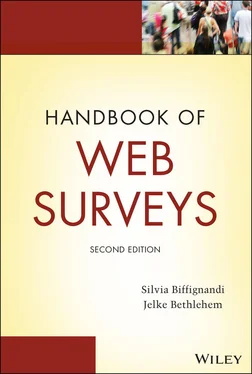1 ...7 8 9 11 12 13 ...35 A way to avoid the under‐coverage problems of telephone directories is to apply random digit dialing (RDD) to generate random phone numbers. A computer algorithm computes valid random telephone numbers. Such an algorithm is able to generate both listed and unlisted numbers. Thus, there is complete coverage. An example of an algorithm used in the United Kingdom is to take a number from a directory and replace its last digit by a random digit. RDD also has drawbacks. In some country it is not clear what an unanswered number means. It can mean that the number is not in use. This is a case of over‐coverage. No follow‐up is needed. It can also mean that someone simply does not answer the phone, which is a case of nonresponse, which has to be followed up. Another drawback of RDD is that there is no information at all about nonrespondents. This makes correction for nonresponse very difficult (Bethlehem, Cobben, and Schouten (2011), see also Chapter 12).
The choice of the mode of data collection is not any easy one. It is usually a compromise between quality and costs. In large countries (like the United States) or sparsely populated countries (like Sweden), it is almost impossible to collect survey data by means of face‐to‐face interviewing. It requires so many interviewers that have to do so much traveling that the costs would be very high. Therefore, it is not surprising that telephone interviewing emerged here as a major data collection mode. In a very small and densely populated country, like the Netherlands, face‐to‐face interviewing is much more attractive. Coverage problems of telephone directories and low response rates also play a role in the choice for face‐to‐face interviewing. More about data collection issues is in Couper et al. (1998).
1.2.3 THE ERA OF COMPUTER‐ASSISTED INTERVIEWING
Collecting survey data can be a costly and time‐consuming process, particularly if high‐quality data are required, the sample is large, and the questionnaire is long and complex. Another problem of traditional data collection is that the completed paper questionnaire forms may contain many errors. Substantial resources must therefore be devoted to cleaning the data. Extensive data editing is required to obtain data of acceptable quality.
Rapid developments in information technology since the 1970s have made it possible to reduce these problems. By introducing microcomputers for data collection, important innovation in surveys took place. A computer program for asking questions and recording the answers replaced the paper questionnaire.
The computer took control of the interviewing process, and it checked answers to the questions. Thus, computer‐assisted interviewing (CAI) emerged.
CAI comes in different modes of data collection. The first mode of data collection that emerged was computer‐assisted telephone interviewing (CATI). Couper and Nicholls (1998) describe its development in the United States in the early 1970s. The first nationwide telephone facility for surveys was established in 1966. The idea at that time was not implementation of CAI but simplifying sample management. The initial systems evolved in subsequent years into full featured CATI systems. Particularly in the United States, there was a rapid growth of the use of these systems. CATI systems were little used in Europe until the early 1980s.
Interviewers in a CATI survey operate a computer running interview software. When instructed to do so by the software, they attempt to contact a selected person by telephone. If this is successful and the person is willing to participate in the survey, the interviewer starts the interviewing program. The first question appears on the screen. If correctly answered, the software proceeds to the next question on the route through the questionnaire.
Call management is an important component of the CATI systems. Its main function is to offer the right telephone number at the right moment to the right interviewer. This is particularly important in cases in which the interviewer has made an appointment with a respondent for a specific time and date. Such a call management system also has facilities to deal with special situations like a busy number (try again after a short while) or no answer (try again later). This all helps to increase the response rate. More about the use of CATI in the United States is in Nicholls and Groves (1986).
Small portable computers came on the market in the 1980s. This made it possible for the interviewers to take computers with them to the respondents. This is the computer‐assisted form of face‐to‐face interviewing, called computer‐assisted personal interviewing (CAPI). After interviewers have obtained cooperation of the respondents, they start the interviewing program. Questions display is one at a time. Only after the entering of the answer, the next question appeared on the screen.
At first, it was not completely clear whether this mode of data collection could use the computer. There were issues like the weight and size of the computer, the readability of the screen, battery capacity, and the size of keys on the keyboard. Experiments showed that CAPI was feasible. It became clear that CAI for data collection has three major advantages:
It simplifies the work of interviewers. They do not have to pay attention any more to choosing the correct route through the questionnaire. The computer determines the next question to ask. Interviewers can concentrate more on asking questions and helping respondents giving the proper answers.
It improves the quality of the collected data. Answers checking is by the software during the interview. Correction of the detected errors is automatic. The respondent is there to provide the proper information. This is much more effective than having to do data editing afterward in the survey agency and without the respondent.
Data entering in the computer is immediate, during the interview. Straightaway checks are undertaken and detected errors corrected. Therefore, the record of a respondent is “clean” after completion of the interview. No more subsequent data entry and/or data editing is required. Compared with the old days of traditional data collection with paper forms, this considerably reduces time needed to process the survey data. Therefore, timeliness of the survey results is improved.
Or more information about CAPI in general, see Couper et al. (1998).
The computer‐assisted mode of mail interviewing also emerged. It was called computer‐assisted self‐interviewing (CASI), or sometimes also computer‐assisted self‐administered questionnaires (CASAQ). The electronic questionnaire program is sent to the respondents. They run the software, which asks the questions and stores the answers. After the interview completion, the data are send back to the survey agency. Early CASI applications used diskettes or a telephone and modem to transmit the questionnaire and the answers to the question. Later it became common practice to use the Internet as a transport medium.
A CASI survey is only feasible if all respondents have a computer on which they can run the interview program. Since the use of computers was more widespread among companies than among households in the early days of CASI, the first CASI applications were business surveys. An example is the production of fire statistics in the Netherlands in the 1980s. Since all brigades had a microcomputer at that time, data for these statistics CASI were a mode of data collection. Diskettes were sent to the fire brigades. They ran the questionnaire on their MS‐DOS computers. The answers were stored on the diskette. After having completed the questionnaire, the diskette was returned to Statistics Netherlands.
An early application in social surveys was the Telepanel , set up by Saris (1998). The Telepanel started in 1986. It was a panel of 2,000 households. They agreed on regularly completing questionnaires with the computer equipment provided to them by the survey organization. A home computer was installed in each household. It was connected to the telephone with a modem. It was connected to the television set in the household also. Then it was possible to use it as a monitor. After inserting the diskette into the home computer, it automatically established a connection with the survey agency to exchange information (downloading a new questionnaire or uploading answers of the current questionnaires). Panel members completed a questionnaire each weekend. The Telepanel was in essence very similar to the web panels, which are frequently used nowadays. The only difference was the Internet did not exist yet.
Читать дальше












